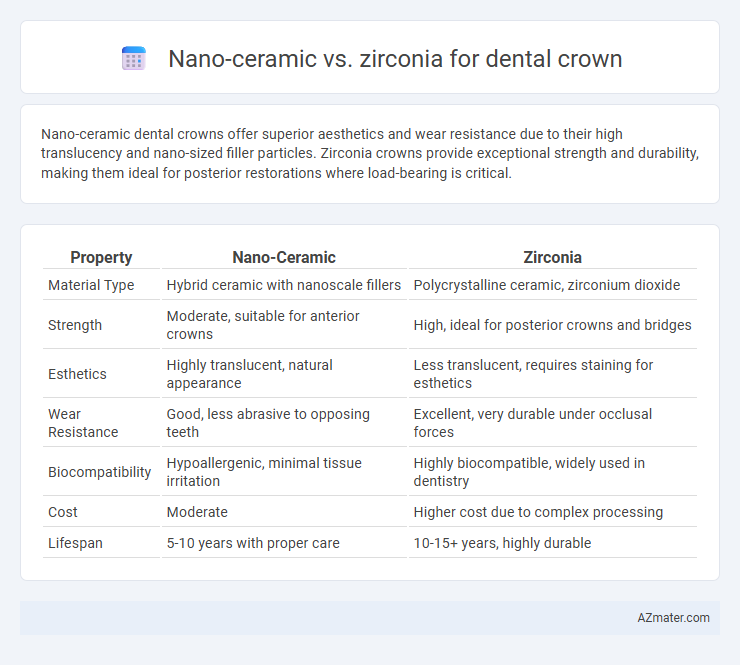Nano-ceramic dental crowns offer superior aesthetics and wear resistance due to their high translucency and nano-sized filler particles. Zirconia crowns provide exceptional strength and durability, making them ideal for posterior restorations where load-bearing is critical.
Table of Comparison
| Property | Nano-Ceramic | Zirconia |
|---|---|---|
| Material Type | Hybrid ceramic with nanoscale fillers | Polycrystalline ceramic, zirconium dioxide |
| Strength | Moderate, suitable for anterior crowns | High, ideal for posterior crowns and bridges |
| Esthetics | Highly translucent, natural appearance | Less translucent, requires staining for esthetics |
| Wear Resistance | Good, less abrasive to opposing teeth | Excellent, very durable under occlusal forces |
| Biocompatibility | Hypoallergenic, minimal tissue irritation | Highly biocompatible, widely used in dentistry |
| Cost | Moderate | Higher cost due to complex processing |
| Lifespan | 5-10 years with proper care | 10-15+ years, highly durable |
Introduction to Dental Crowns: Nano-ceramic vs Zirconia
Nano-ceramic and zirconia are two advanced materials commonly used for dental crowns, each offering unique benefits in dental restoration. Nano-ceramic crowns provide excellent esthetics with a translucent appearance closely mimicking natural teeth, making them ideal for front teeth restoration. Zirconia crowns are renowned for exceptional strength and durability, often preferred for molars where high bite forces require enhanced resistance to fractures.
Material Composition and Technology
Nano-ceramic dental crowns consist of resin-based composites enhanced with nanoscale ceramic particles, offering improved aesthetics and flexibility compared to traditional materials. Zirconia crowns are made from zirconium dioxide, a dioxyde ceramic known for exceptional strength, durability, and biocompatibility, often fabricated using CAD/CAM technology for precision. Advanced sintering and milling techniques enable zirconia crowns to achieve superior fracture resistance and longevity over nano-ceramic alternatives in high-stress dental applications.
Esthetics: Shade and Natural Appearance
Nano-ceramic dental crowns offer superior translucency and a wider range of shade customization, closely mimicking the natural enamel for a highly aesthetic result. Zirconia crowns excel in durability but have a more opaque appearance, which can limit their natural look, especially in front teeth where aesthetics are paramount. Advanced layering techniques in zirconia crowns improve shade matching, yet nano-ceramic remains the preferred choice for patients prioritizing ultra-natural appearance and seamless integration with surrounding teeth.
Strength and Durability Comparison
Nano-ceramic dental crowns offer excellent flexibility and resistance to chipping, but zirconia crowns surpass them in strength, boasting flexural strength values typically around 900-1200 MPa compared to nano-ceramics' 200-400 MPa. Zirconia's superior durability and high fracture toughness make it ideal for high-stress areas like molars, ensuring longer-lasting restorations under heavy bite forces. Nano-ceramics provide aesthetic advantages and moderate wear resistance, but zirconia remains the gold standard in crown materials when maximum strength and longevity are critical.
Biocompatibility and Patient Comfort
Nano-ceramic dental crowns demonstrate excellent biocompatibility by minimizing allergic reactions and promoting gum health through their chemically inert properties. Zirconia crowns also offer superior biocompatibility, with strong resistance to plaque buildup and low thermal conductivity, which helps reduce tooth sensitivity. Patient comfort is enhanced with nano-ceramics due to their natural translucency and lightweight structure, while zirconia provides durability and a snug fit, contributing to long-term comfort during chewing and speaking.
Resistance to Wear and Fracture
Nano-ceramic dental crowns exhibit excellent resistance to wear due to their enhanced particle distribution and flexibility, reducing abrasion on opposing teeth. Zirconia crowns are renowned for superior fracture toughness and durability, offering high resistance against chipping and cracking under heavy masticatory forces. Both materials provide reliable longevity, but zirconia's high flexural strength (900-1200 MPa) makes it preferable in high-stress posterior restorations.
Suitability for Different Tooth Positions
Nano-ceramic crowns offer excellent aesthetics and are highly suitable for front teeth due to their natural translucency and color-matching capabilities. Zirconia crowns provide superior strength and durability, making them ideal for molars and premolars subjected to high biting forces. The choice between nano-ceramic and zirconia depends largely on the balance between aesthetic demands and functional requirements for the specific tooth position.
Preparation and Placement Procedures
Nano-ceramic dental crowns require minimal tooth reduction due to their superior strength and flexibility, preserving more natural tooth structure compared to zirconia crowns. Zirconia crowns demand more extensive tooth preparation to ensure proper fit and retention, often involving deeper reduction and precise margin design. Placement of nano-ceramic crowns is generally less invasive and can sometimes be completed with adhesive cements, while zirconia crowns usually require resin-modified glass ionomer cement or dual-cure resin cement for optimal bonding and longevity.
Cost and Accessibility
Nano-ceramic dental crowns generally offer a more affordable option compared to zirconia crowns, appealing to patients with budget constraints. Zirconia crowns are typically higher in cost due to their superior strength, durability, and aesthetic qualities, often recommended for long-term use and more visible teeth. Accessibility varies as nano-ceramic materials are widely available in standard dental clinics, while zirconia crowns may require specialized labs or advanced equipment, potentially limiting their immediate availability.
Making the Right Choice: Factors to Consider
Choosing between nano-ceramic and zirconia dental crowns depends on factors such as strength, aesthetics, and biocompatibility. Nano-ceramic crowns offer superior translucency and natural appearance, making them ideal for front teeth, while zirconia crowns provide exceptional durability and resistance to wear, suitable for molars and high-bite pressure areas. Patient-specific considerations like gum sensitivity, cosmetic preference, and budget also influence the optimal choice for long-term dental restoration success.

Infographic: Nano-ceramic vs Zirconia for Dental crown
 azmater.com
azmater.com